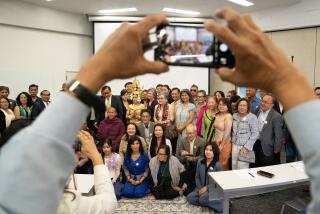Steadfastness Against Khmer Rouge Should Gird Policy on Cambodia
Ten years after being driven from Phnom Penh by invading Vietnamese forces, the dreaded Khmer Rouge is back, ready to deploy 30,000 troops and equipped with a two-year supply of arms furnished by China and now stockpiled inside Cambodia.
With occupying Vietnamese forces scheduled to withdraw from Cambodia by Sept. 30, U.S. national interests require prompt action to prevent the Khmer Rougeâs return to power and to promote peace for the people of Cambodia.
There are promising signs of an emerging compromise between Prince Norodom Sihanouk, leader of the three-party resistance coalition, and Cambodian Premier Hun Sen, who was originally installed with Vietnamâs support.
After the recent meeting between Hun Sen and Sihanouk in Indonesia, Sihanouk indicated that he is willing to return to Phnom Penh as head of state under certain conditions, even if he must abandon his allies in the Khmer Rouge. Points of agreement now include creation of an âinternational control mechanismâ to monitor Vietnamese troop withdrawals and to help monitor free elections.
Yet, even as opportunities for peace appear, the danger of chaos and another bloody massacre of the Cambodian people by the Khmer Rouge also appears possible. From its encampment inside Thailand, the Khmer Rouge continues to build its forces for resumed civil war in Cambodia.
Since being driven from power, the Khmer Rouge has been financed by China. Astonishingly, the Khmer Rouge also has received indirect support from Washington since we aid Sihanouk in his uneasy alliance with the Khmer Rouge. And we have joined the international community in legitimizing the Khmer Rouge by granting it, along with its coalition partners, Cambodiaâs seat in the United Nations.
The legitimization of the Khmer Rouge has proven an embarrassment, yet it has not been destructive. It did serve the purpose of protesting the Vietnamese occupation. But our support for the coalition threatens to materially aid the Khmer Rouge in its new grab for power. Some U.S. policy-makers argue that backing a Sihanouk-Khmer Rouge coalition is the only promising option; that only such a coalition will have enough soldiers to be a viable alternative to Hun Senâs government. Thus, it is argued, giving lethal aid to Sihanouk will provide his forces the leverage to oust Hun Sen while preventing the Khmer Rouge from again seizing control.
This argument has some serious flaws. It assumes that the complete dismantling of Hun Senâs government is essential. Yet this would be a disaster. True, Hun Senâs government was first installed by an occupying army. But Hun Sen has initiated programs in education and industry that have gone far beyond anything Cambodia has had to date, and he has proved far more tolerant than his Vietnamese supporters. By building on these modest successes, the Cambodian people would be closer to securing a legitimate, stable and, in time, a democratically elected government.
While military aid may bolster Sihanoukâs bargaining position, it also will benefit the Khmer Rouge while its alliance with him remains in force. Our aid would be channeled through the Thai military, already accused of diverting U.S. assistance intended for Cambodian refugee camps. The Thai record gives little assurance that military aid to Sihanouk would not also reach the Khmer Rouge.
Finally, providing military aid now will make a negotiated settlement even more remote. Deng Xiaoping is as blindly attached to the cause of the Khmer Rouge as Ronald Reagan was to the Nicaraguan Contras. If the United States arms Sihanouk now, the likelihood that the Chinese will abandon their clients decreases dramatically.
Then, how can the United States best aid the Cambodian people? Americaâs fundamental objective can be met by steadfastly refusing to countenance a return of the Khmer Rouge. This means pressing Sihanouk to withdraw from his alliance with the Khmer Rouge. It means being willing to provide military aid to a nationalist coalition in the event of Khmer Rouge aggression, but not until then. The United States should actively promote an interim coalition government involving both Sihanouk and Hun Sen that would serve until internationally supervised elections could be held. We should also promote an international conference on Cambodia with two objectives: establishment of an international peacekeeping force to supervise fair elections and support for a recovery program in the post-settlement period. Finally, we should push for withdrawal of U.N. recognition from the Khmer Rouge-backed alliance, leaving the Cambodian seat vacant until a more legitimate government is in place.
There is no ideal solution to Cambodiaâs painful dilemma. But the United States--indeed, the whole international community--has an obligation to do everything possible to avoid bloodshed and to afford the Cambodian people an opportunity to choose their own government and to build a productive society. Legitimizing a role for the Khmer Rouge is not the way. Neither is ill-considered military aid. Negotiation based on hard realities and backed by credible promises of assistance by the international community is the most promising course. We should give that our full support.
More to Read
Sign up for Essential California
The most important California stories and recommendations in your inbox every morning.
You may occasionally receive promotional content from the Los Angeles Times.










